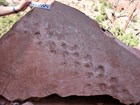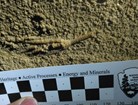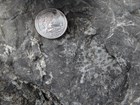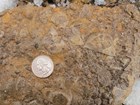During the Paleozoic Era (541 to 252 million years ago), fish diversified and marine organisms were very abundant. In North America, the Paleozoic is characterized by multiple advances and retreats of shallow seas and repeated continental collisions that formed the Appalachian Mountains. Common Paleozoic fossils include trilobites and cephalopods such as squid, as well as insects and ferns. The greatest mass extinction in Earth's history ended this era.
-
Article 1: Permian Period—298.9 to 251.9 MYA

The massive cliffs of El Capitan in Guadalupe Mountains National Park represent a Permian-age reef along the supercontinent Pangaea. The uppermost rocks of Grand Canyon National Park are also Permian. Read more
-
Article 2: Pennsylvanian Period—323.2 to 298.9 MYA

Rocks in Cumberland Gap National Historical Park represent vast Pennsylvanian-age swamps. Plant life in those swamps later became coal found in the eastern United States. Read more
-
Article 3: Mississippian Period—358.9 to 323.2 MYA

The extensive caves of Mammoth Cave and Wind Cave national parks developed in limestone deposited during the Mississippian. Warm, shallow seas covered much of North America, which was close to the equator. Read more
-
Article 4: Devonian Period—419.2 to 358.9 MYA

The Devonian is part of the “Age of Fishes.” Fish fossils from Death Valley National Park shed light on the early evolution of fish in North America. Tilted Devonian rocks in Chesapeake & Ohio Canal National Historical Park attest to continued Appalachian Mountain formation. Read more
-
Article 5: Silurian Period—443.8 to 419.2 MYA

Excellent exposures and well-preserved fossils in Silurian rocks of Glacier Bay National Park & Preserve provide clues to the timing of the assembly of Alaska’s assembly from a variety of continental fragments. Read more
-
Article 6: Ordovician Period—485.4 to 443.8 MYA

Shenandoah and Great Smoky Mountains national parks, along with the Blue Ridge Parkway that connects them, pass through rocks from the core of the Appalachian Mountains. The mountains began forming during the Ordovician and eventually attained elevations similar to those of the Himalayas. Read more
-
Article 7: Cambrian Period—541 to 485.4 MYA

The flat layers of rock exposed in Grand Canyon National Park encompass much of the Paleozoic, beginning in the Cambrian where they record an ancient shoreline. Read more
